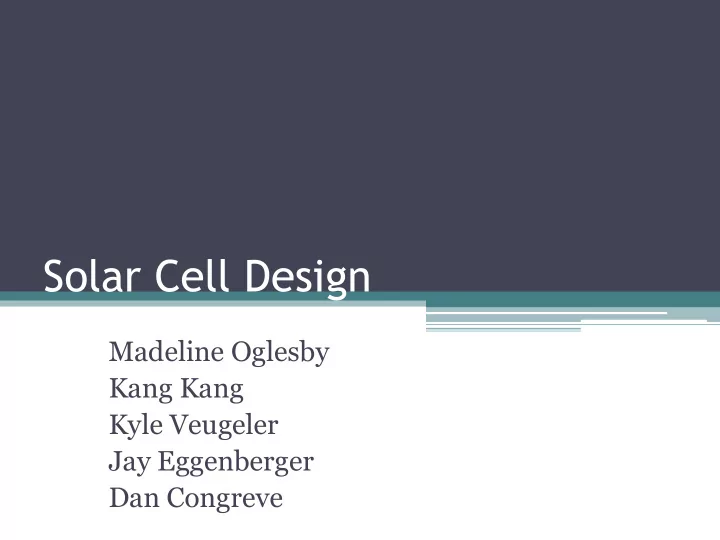

Solar Cell Design Madeline Oglesby Kang Kang Kyle Veugeler Jay Eggenberger Dan Congreve
Spectrum Splitting Overview • Spectrum Splitting ▫ Different materials in p-i-n junctions have unique optical properties ▫ Use two or more layers with different optical properties This can maximize the range of absorbed wavelengths • Tandem Junction Solar Cell ▫ A solar cell with two of these layers • Current Matching ▫ Layers are connected in series ▫ Current through each layer must be the same ▫ Effective current of both layers is limited by the layer with the lowest current.
Current Matching Equations • Carrier Calculation for a-Si layer: • Carrier Calculation for nc-Si layer: • Current Matching Equation (yields ratio of t a-Si to t nc-Si ): =
Anti-Reflective Coating Definition • Layer of transparent conductive oxide • Serves as the top contact for the solar cell Goals • Minimize absorption and reflection losses for incident light of wavelengths 400-1100 nm • Provide good electrical contact while letting most of the incident light pass through to the a-Si and nc-Si layers where the photo-generation of current occurs
Solar Cell Optics Simulator
ARC Metric • Red line: Average reflection over 400-1100 nm range • Blue line: Average absorption in ARC • Black line: Sum of reflection and ARC absorption (loss) • Optimal case is minimum of black line
Current Findings ARC Material Optimal Thickness Light R+A Bare Layer No ARC 0 nm 56.14% ITO (Layer 1) 67 nm 44.73% SnO 2 (Layer 1) 69 nm 41.62% SnO 2 /ITO Mix(Layer 1) 78 nm 42.55% ZnO 67 nm 41.83% (ITO/SnO 2 )/ZnO 32nm(ITO) 45nm(ZnO) 41.14% (ITO/SnO 2 )/ITO 39nm(ITO/SnO 2 ) 40nm 41.83% (ITO)
Implementation Process Determine Design Analyze Results Fabricate Cell Test Cell
Testing Procedures • Quantum Efficiency ▫ Carriers Collected/Carriers Absorbed at a specific wavelength ▫ Shows potential flaws in the device • I-V Curve ▫ Taken at various temperatures ▫ Shows how the device will operate in real world conditions
Testing Procedures • C-V Curve ▫ Act as design verification and guide ▫ Calculate physical thickness of the device • Optical Properties ▫ Measure Reflection & Transmission ▫ Study the effectiveness of ARC ▫ Determine physical thickness
Recommend
More recommend